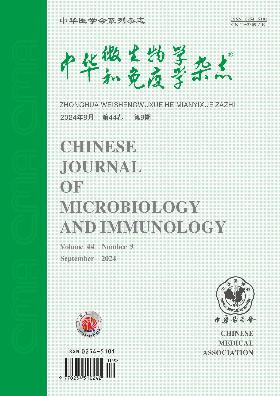Bcl-2/腺病毒E1B19kDa相互作用蛋白3在手足口病患者中的临床意义
Q4 Immunology and Microbiology
引用次数: 0
摘要
目的探讨Bcl-2/腺病毒E1B19kDa相互作用蛋白3(BNIP3)在手足口病(HFMD)患者血清和脑脊液中的表达及其临床意义。方法将90例手足口病患儿分为三组,每组30例:危重组(临床3期)、重症组(临床2期)和普通组(临床1期,不包括脑脊液脑炎等检查)。另外30名健康儿童被随机选为对照组。治疗前后检测血清和CSF中BNIP3的水平。此外,还测定了血清神经特异性烯醇化酶(NSE)和S100B蛋白,以分析它们与BNIP3的相关性。受试者操作特征(ROC)曲线用于评估BNIP3对手足口病严重程度的预测效率。结果危重组血清BNIP3、S100B蛋白和NSE水平均高于其他三组(P<0.01),S100B蛋白和NSE在重症组明显高于普通组和对照组(P<0.01),危重组和重症组血清中S100B蛋白和NSE及CSF中BNIP3均下降(P<0.01),血清和CSF中BNIP 3水平与S100B蛋白及NSE水平呈正相关(P<0.01)。CSF BNIP3在预测严重手足口病时,在1.735μg/L的临界值下具有最高的Youden值,其敏感性为73.33%,特异性为93.33%。结论BNIP3参与了重型手足口病患儿脑损伤的病理过程。BNIP3的检测有助于评估手足口病的严重程度和预后。关键词:Bcl-2/腺病毒E1B19kDa相互作用蛋白3;手足口病;儿童本文章由计算机程序翻译,如有差异,请以英文原文为准。
Clinical significance of Bcl-2/adenovirus E1B19kDa interacting protein 3 in patients with hand, foot and mouth disease
Objective
To investigate the expression and clinical significance of Bcl-2/adenovirus E1B19kDa interacting protein 3 (BNIP3) in serum and cerebrospinal fluid (CSF) of patients with severe hand, foot and mouth disease (HFMD).
Methods
Ninety children with HFMD were classified into three groups with 30 in each group: critical group (clinical stage 3), severe group (clinical stage 2) and common group (clinical stage 1, excluding encephalitis with CSF and other examinations). Another thirty healthy children were randomly selected as the control group. The levels of BNIP3 in serum and CSF were detected before and after treatment. Moreover, serum neuro-specific enolase (NSE) and S100B protein were also measured to analyze their correlation with BNIP3. Receiver operating characteristic (ROC) curve was used to evaluate the prediction efficiency of BNIP3 for the severity of HFMD.
Results
The levels of serum BNIP3, S100B protein and NSE in the critical group were higher than those in the other three groups (P<0.01). CSF BNIP3 level in the critical group were significantly higher than that in the common and severe groups (P<0.01). Serum BNIP3, S100B protein and NSE were significantly higher in the severe group than in common and control groups (P<0.01). CSF BNIP3 was significantly increased in the severe group as compared with that in the common group (P<0.01). After treatment, the levels of BNIP3, S100B protein and NSE in serum and BNIP3 in CSF were decreased in both critical and severe groups (P<0.01). The levels of BNIP3 in serum and CSF were positively correlated with the level of S100B protein and NSE (P<0.01). Serum BNIP3 had the highest Youden value at the cut-off value of 3.015 μg/L, with a sensitivity of 83.33% and a specificity of 90.00%, in the prediction of severe HFMD. CSF BNIP3 had the highest Youden value at the cut-off value of 1.735 μg/L, with a sensitivity of 73.33% and a specificity of 93.33%, in the prediction of severe HFMD.
Conclusions
BNIP3 is involved in the pathological process of brain injury in children with severe HFMD. Detection of BNIP3 helps evaluate the severity and prognosis of HFMD.
Key words:
Bcl-2/adenovirus E1B 19kDa interacting protein 3; Hand, foot and mouth disease; Child
求助全文
通过发布文献求助,成功后即可免费获取论文全文。
去求助
来源期刊

中华微生物学和免疫学杂志
Immunology and Microbiology-Virology
CiteScore
0.50
自引率
0.00%
发文量
6906
期刊介绍:
Chinese Journal of Microbiology and Immunology established in 1981. It is one of the series of journal sponsored by Chinese Medical Association. The aim of this journal is to spread and exchange the scientific achievements and practical experience in order to promote the development of medical microbiology and immunology. Its main contents comprise academic thesis, brief reports, reviews, summaries, news of meetings, book reviews and trends of home and abroad in this field. The distinguishing feature of the journal is to give the priority to the reports on the research of basic theory, and take account of the reports on clinical and practical skills.
 求助内容:
求助内容: 应助结果提醒方式:
应助结果提醒方式:


